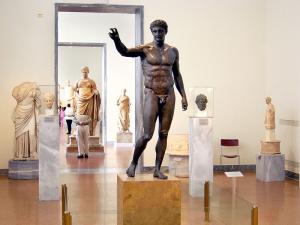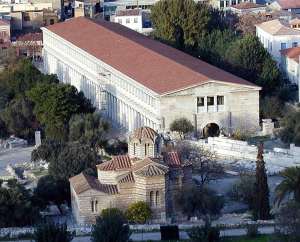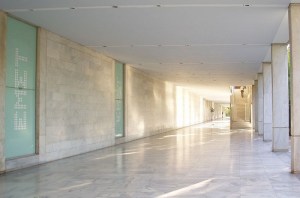|
|
| |
GREECE
ATHENS MUSEUMS
National Archaeological Museum The National Archaeological Museum houses some of the most important artifacts from a variety of archaeological locations around Greece from prehistory to late antiquity. It is considered one of the great museums in the world and contains the richest collection of artifacts from Greek antiquity worldwide. The museum is accessible with the Athens metro. The nearest stations are Viktoria station and Omonia station. It is located in the Exarhia area in central Athens between Epirus Street, Bouboulinas Street and Tositsas Street while its entrance is on the Patission Street adjacent to the historical building of the Athens Polytechnic. The museum's collections are organised in nine sections: prehistoric (Neolithic, Cycladic, Mycenaean), sculptures, vases and minor objects, Santorini findings, Metallurgy collection, Stathatos collection, Vlastos collection, Egyptian art and the Near Eastern antiquities collection.
The prehistoric collection displays objects from the Neolithic era (6800-3000 BC), Early and Mid-Bronze age (3000-2000 BC and 2000 to 1700 BC respectively), objects classified as Cycladic and Mycenaean art. There are ceramic finds from various important Neolithic sites such as Dimini and Sesclo from middle Helladic ceramics from Boeotia, Attica and Phthiotis. Some objects from Heinrich Schliemann excavations in Troy are also on display. The cycladic collection features the famous marble figurines from the Aegean islands of Delos and Keros including the Lutist. Mycenean civilization is represented by stone, bronze and ceramic pots, figurines, ivory, glass and faience objects, golden seals and rings from the vaulted tombs in Mycenae and other locations in the Peloponnese (Tiryns and Dendra in Argolis, Pylos in Messinia and Vaphio in Lakonia). The Egyptian collection dates back to the last twenty years of the 19th century. In total the collection includes more than 6000 artefacts.The collection is considered to be one of the best collections of Egyptian art in the world. The exhibition features rare statues, tools, jewels, mummies, a wooden body tag for a mummy, a stunning bronze statue of a princess and hundreds of other artifacts. The Stathatos collection features about 1000 objects mainly jewels as well as metal objects, vases and pottery from the Middle Bronze Age to post-Byzantine era.
The museum houses a 118 year old library of archeology with rare ancient art, science and philosophy books and publications. The library holds some 20,000 volumes, including rare editions dating to the 17th century. There are also conservation laboratories, photographic archives and chemistry laboratories located within the museum.
The national archaeological museum is a must see for anyone visiting Greece. With so many cheap holidays to Greece, you simply cannot miss on the chance to visit a museum that has so much to offer.
For more information and enquiries please contact National Archaeological Museum, 44 Patission Street, Athens 10682, Offices: 1 Tositsa Street, Athens 10682, Greece, Tel: +30 210 8217724 / +30 210 8217717. E-mail: eam@culture.gr
 The Antikythera Ephebe, National Archaeological Museum of Athens Photograph taken by Ricardo André Frantz
Acropolis MuseumThe Acropolis Museum is an archaeological museum focused on the findings of the archaeological site of the Acropolis of Athens. The museum was built to house every artifact found on the rock and on its feet, from the Greek Bronze Age to Roman and Byzantine Greece. It also lies on the archaeological site of Makrygianni and the ruins of a part of Roman and early Byzantine Athens. The entrance to the building is on Dionysiou Areopagitou Street and directly adjacent to the Akropoli station, line 2 of the Athens Metro. The museum is located by the southeastern slope of the Acropolis hill, on the ancient road that led up to the "sacred rock" in classical times. As the museum is built over an extensive archaeological site, the floor, outside and inside, is often transparent using glass and thus the visitor can see the excavations below. Housed are also artifacts and sculptures from the other Acropolis buildings such as the Erechtheum, the Temple of Athena Nike and the Propylaea and findings from Roman and early Christian Athens. The museum also provides an amphitheatre, a virtual theatre and a hall for temporary exhibitions.
For more information and enquiries please contact Acropolis Museum,
15 Dionysiou Areopagitou Street,
Athens 11742, Tel: +30 210 9000900, E-mail: info@theacropolismuseum.gr
 The newly built Acropolis Museum seen from above Photograph taken by Dimboukas
Athens War Museum The Athens War Museum is the museum of the Greek Armed Forces. Its purpose is the exhibition of weapon artifacts and the relevant research in the history of war. It covers the history of war in all ages. The museums' collections include the collection of the Greek Army, with artifacts from other civilizations such as Ancient China and Ancient Japan. The museum's centerpieces are weaponry from wars in which Greece was involved. After building the Hellenic Air Force Museum, some airplanes were brought to this museum.
For more information and enquiries please contact Vassilissis Sophias Avenue/2, Rizari Street, 106 75 Athens, Tel: +30 210 - 7252974, E-mail: info@warmuseum.gr
 Athens War Museum seen from the front Photograph taken by Lapost
The National Historical Museum of Greece, AthensThe National Museum of Greece is housed in the Old Parliment building at Stadiou Street in Athens. The building housed the Greek Parliment between 1875 and 1932. The museum houses the collection of the Historical and Ethnological Society of Greece. It is the oldest collection of its kind in Greece, and prior to its transfer in the Old Parliament, was housed in the main building of the National Technical University. The collection contains historical items concerning the period from the fall of Constantinople to the Ottomans in 1453 to the Second World War, focusing especially in the period of the Greek Revolution and the subsequent establishment of the modern Greek state. Among the items displayed are weapons, personal belongings and memorabilia from historical personalities, historical paintings by Greek and foreign artists, manuscripts, as well as a large collection of traditional costumes from the various regions of Greece. The collection is displayed in the corridors and rooms of the building, while the great central hall of the National Assembly is used for conferences.
For more information and enquiries please contact Historical and Ethnological Society of Greece, National History Museum, Old Mansion House, Stadioy 13, 105 61 Athens, Tel: (+30 210) 32 37 617, info@nhmuseum.gr, E-mail: info@nhmuseum.gr
 Bronze statue of Theodoros Kolokotronis in front of the Parliament House
Museum of the Ancient AgoraThe Stoa of Attalos houses the Museum of the Ancient Agora. Its exhibits are mostly connected with the Athenian democracy. The collection of the museum includes clay, bronze and glass objects, sculptures, coins and inscriptions from the 7th to the 5th century BC, as well as pottery of the Byzantine period and the Turkish occupation. The Stoa of Attalos is recognised as one of the most impressive stoĉ in the Athenian Agora. It was built by and named after King Attalos II of Pergamon who ruled between 159 BC and 138 BC. The stoa is identified as a gift to the city of Athens for the education that Attalos received there. In the 1950s, the Stoa of Attalos was fully reconstructed and made into the Ancient Agora Museum.
For more information and enquiries please contact The Museum of the Ancient Agora (The Stoa of Attalos) The Agora, 10555 Athens, Greece, Tel: +30 21 0870 7000, E-mail: info@athensinfoguide.com
 The restored Stoa of Attalos in Athens Photograph taken by Marsyas
National Museum of Contemporary Art, AthensThe National Museum of Contemporary Art (EMST) is a national institution focused on collecting and exhibiting contemporary Greek and international art in Athens. The museum is developing its permanent collections through purchasing works of art as well as soliciting donations. EMST aims at developing, within the next few years, a core collection of works representative of the basic directions of contemporary art. Among the most important acquisitions are works by Ilya Kabakov, Stephen Antonakos, Gary Hill, Nan Goldin, Vadim Zakharov, Gillian Wearing, Ann Sofi Siden, Vlassis Caniaris, Nikos Kessanlis, Dimitris Alithinos, Nikos Navridis, Joel Sanders, Allan Sekula, Costas Tsoclis, George Hadjimichalis, Chryssa, Jannis Psychopedis, Andreas Angelidakis, Lewis.Tsurumaki.Lewis, Tessera. The Library of EMST includes a significant number of specialized editions and journals on the fields of History and Theory of Art, Museology and Conservation of art works as well as on the field of the History of Philosophy, Anthropology, Architecture and Industrial Design, New Technologies and Multimedia and is constantly enriched in order to serve scientific research and writing.
For more information and enquiries please contact Athens Conservatory Building:
Vassileos Georgiou Β 17 -19 & Rigillis Street
Athens, 10675, Greece, Tel: 210 9242111-3, E-mail: protocol@emst.gr
 National Museum of Contemporary Art Photograph taken by Σταμάτης Σχιζάκης
|
|
|
|
|